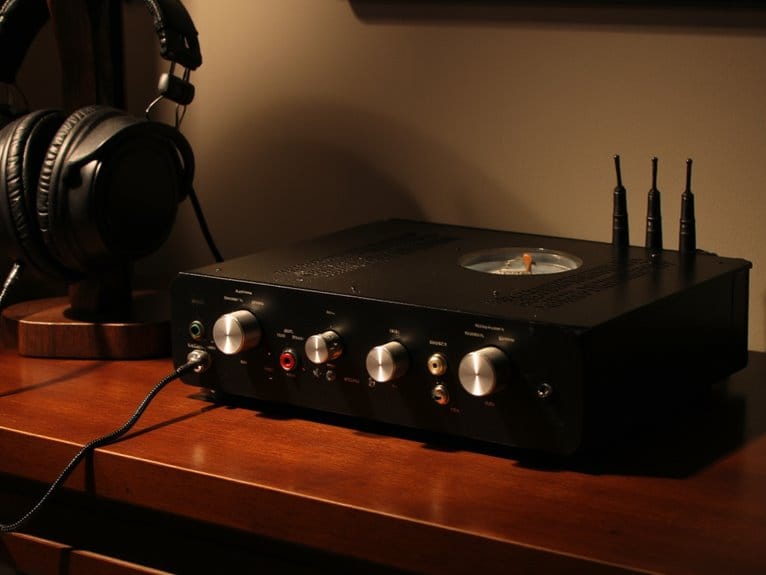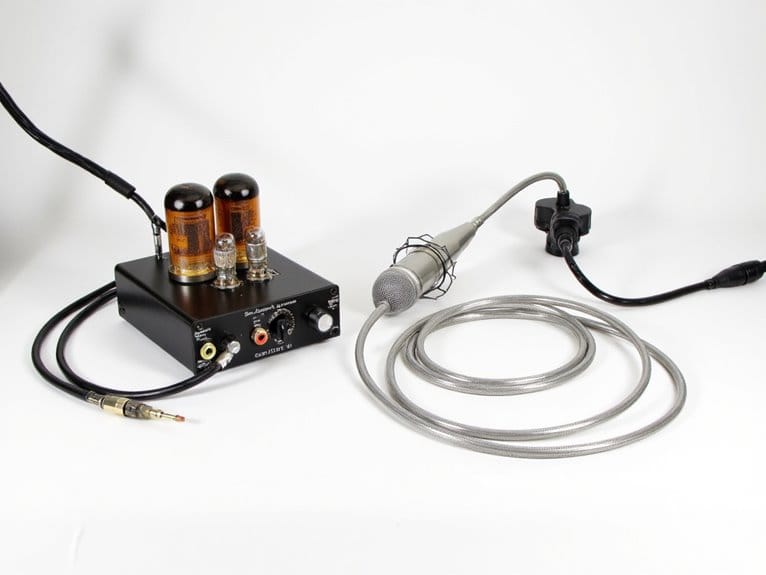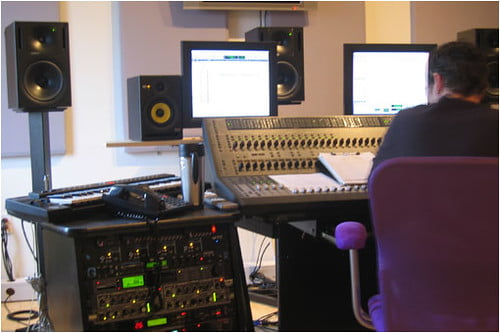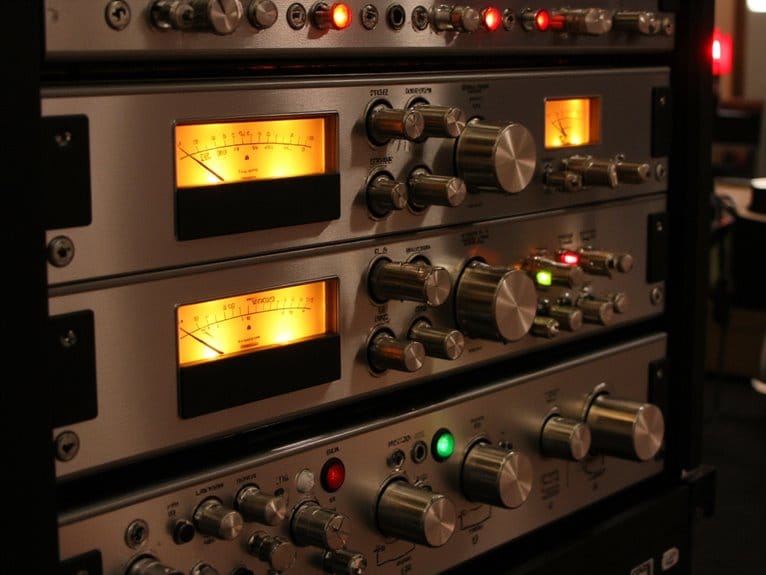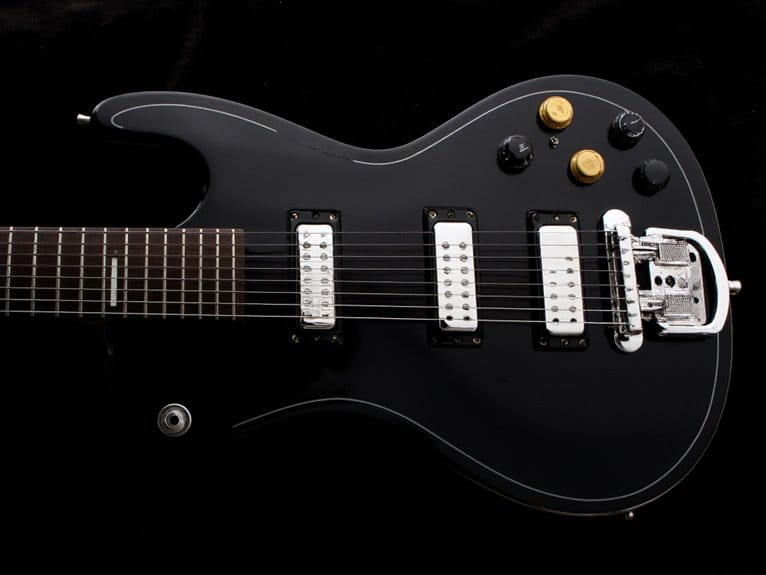How to Choose the Right Headphone Amp for Your Headphones
When choosing a headphone amplifier, you’ll need to match your headphones’ impedance with an amp that has an output impedance of one-eighth or less-so 32-ohm headphones require 4-ohm output impedance or lower. Consider your budget range from entry-level ($100-$150) to high-end ($500+), then identify whether you prefer warm tube sound or clean solid-state performance. Make certain the amp provides 50% more power than required and offers connectivity that matches your current setup, as proper selection transforms your entire listening experience.
We are supported by our audience. When you purchase through links on our site, we may earn an affiliate commission, at no extra cost for you. Learn more.
Notable Insights
- Match your headphones’ impedance with an amp output impedance of one-eighth or less for optimal power transfer and reduced distortion.
- Determine your preferred sound signature (flat, warm, V-shaped) to ensure amp compatibility with your headphones’ natural characteristics.
- Set a clear budget considering entry-level ($100-$150), mid-range ($200-$500), or high-end ($500+) amplifiers based on your headphone quality.
- Evaluate essential connectivity options like analog inputs, USB/digital inputs, and output types to ensure compatibility with your current gear.
- Choose between amplifier types: solid-state for clean sound, tube for warmth, or hybrid designs for balanced performance.
Understanding Different Types of Headphone Amplifiers
When I first dove into the world of headphone amplifiers, I’ll admit the sheer variety of options felt overwhelming, but understanding the fundamental differences between amplifier types quickly became the foundation for making informed decisions.
Solid state advantages include their durability, clean sound signature, and energy efficiency, making them perfect for critical listening sessions where precision matters most.
Solid state amplifiers deliver uncompromising precision and reliability for audiophiles who demand clinical accuracy in their critical listening experiences.
Tube characteristics offer that warm, harmonically rich presentation many audiophiles crave, though they require more maintenance and generate additional heat. Premium tube amplifiers like the Auris Audio Nirvana IV utilize external power supplies to minimize electrical interference and deliver exceptional musical clarity.
Hybrid benefits combine both technologies, using tubes in preamp stages while maintaining solid-state power sections for reliability.
Portable designs sacrifice some power for convenience, while desktop units deliver maximum performance with extensive features and superior heat dissipation capabilities. Digital amplifiers employ pulse-width modulation technology to achieve remarkable efficiency in compact form factors, making them increasingly popular for modern portable audio applications.
Modern desktop amplifiers often incorporate advanced DAC chips like the ES9038PRO to support high-resolution formats including PCM up to 768kHz/32Bit and native DSD512 playback for superior audio quality.
Matching Your Headphones’ Impedance and Power Requirements
Although I’d mastered the different amplifier types, I quickly discovered that understanding impedance and power requirements became the make-or-break factor in creating a truly satisfying audio setup.
You’ll need to match your headphones’ impedance, typically ranging from 8 to 600 ohms, with an amplifier whose output impedance sits at one-eighth or less of your headphones’ rating. For instance, 32-ohm headphones work best with amps featuring 4-ohm output impedance or lower.
This impedance matching facilitates proper power transfer and reduces distortion considerably. Budget amplifiers with ultra-low distortion rates of 0.0003% can deliver surprisingly clean audio reproduction when properly matched to your headphones.
Your power requirements depend heavily on driver technology, as planar magnetic headphones demand substantially more juice than dynamic drivers.
Always verify that your amplifier provides at least 50% more power than needed, creating essential headroom for clean, undistorted sound reproduction.
When working with guitar amps specifically, utilizing a headphone amplifier can enhance audio quality significantly and ensure optimal performance when connecting headphones to your amp setup.
Establishing Your Budget and Investment Strategy
Every dollar I’ve spent on headphone amplification has taught me that establishing a clear budget upfront isn’t just helpful-it’s absolutely essential for making smart purchasing decisions.
Budget constraints shouldn’t feel limiting, but rather helpful guardrails that prevent you from either overspending on unnecessary features or settling for inadequate performance that’ll disappoint you later.
Smart budget boundaries guide you toward amplifiers that deliver real value while preventing costly mistakes and future regrets.
Consider these investment longevity strategies:
- Entry-level models ($100-$150) like the FiiO K11 offer excellent value without compromising core functionality.
- Mid-range options ($200-$500) provide enhanced features and build quality that typically last years longer.
- High-end amplifiers ($500+) deliver premium performance but require matching headphones to justify the expense.
I’ve learned that viewing amplifiers as long-term investments, rather than quick purchases, leads to considerably better satisfaction with your final choice.
Quality amplifiers under $200 typically support 16-600 ohms impedance range, proving that audiophile sound is achievable without breaking your budget. Your amplifier choice becomes even more critical when powering high-impedance headphones like the Beyerdynamic DT 990 Pro 250 Ohm, which require adequate power to reach their full potential.
Identifying Your Preferred Sound Signature
How can you truly know which headphone amp will satisfy your listening preferences without first understanding your preferred sound signature?
Through sound signature exploration, you’ll discover whether you gravitate toward flat, balanced, V-shaped, warm, or bright frequency responses, each offering distinct tonal characteristics that shape your audio experience.
I’ve found that personal preference evaluation requires testing various headphones with your favorite music genres, noting how bass impact, midrange clarity, and treble detail affect your enjoyment.
Classical enthusiasts often prefer warm signatures, while EDM fans typically favor V-shaped profiles with enhanced bass and treble.
Consider your primary use case-casual listening benefits from balanced signatures, whereas professional mixing demands flat response.
This foundational knowledge guarantees your chosen amp complements, rather than conflicts with, your headphones’ natural sound characteristics.
Evaluating Connectivity Options and Essential Features
When I’m evaluating headphone amplifiers, I’ve learned that connectivity options and essential features can make or break your listening experience, regardless of how perfectly you’ve identified your sound preferences.
You’ll need to carefully assess the input and output configurations that match your current gear while considering future upgrades, since mismatched connections can bottleneck even the most expensive headphones.
The integrated features and flexibility of your chosen amplifier will ultimately determine whether it becomes a long-term centerpiece of your audio setup or an expensive paperweight gathering dust on your desk.
Input and Output Options
The connectivity landscape of headphone amplifiers can make or break your entire audio setup, and I’ve learned this lesson the hard way after dealing with countless cable snakes and compatibility nightmares over the years.
Understanding input types and output configurations becomes essential when you’re trying to create a seamless audio chain that actually works together.
- Analog inputs like RCA jacks connect traditional sources such as CD players and turntables, while USB and digital inputs (optical/coaxial) handle computer audio and high-resolution streaming with minimal signal degradation.
- Standard headphone outputs drive your cans properly, but additional line outputs let you connect external amplifiers or powered speakers for expanded system flexibility.
- Balanced outputs provide superior noise rejection in high-end setups, especially when dealing with sensitive, high-impedance headphones that demand clean power delivery.
Integrated Features and Flexibility
While selecting the right inputs and outputs forms your amplifier’s foundation, modern headphone amps have evolved into sophisticated audio swiss army knives that’ll either streamline your entire setup or complicate it beyond belief-and I’ve experienced both extremes firsthand.
Feature versatility manifests through switchable amplifier classes, feedback modes, and independent DSP controls per input, letting you dial in everything from stereo width to analog mid/side processing.
Sound customization reaches impressive depths with built-in equalizers, gain adjustments, and impedance matching that’ll transform how your headphones perform.
The best units function as DAC/amp combos with preamp outputs, fundamentally replacing multiple components while maintaining low THD under load-though you’ll pay premium prices for this Swiss army knife approach.
On a final note
You’ve now got the roadmap to find your perfect headphone amp match. Don’t overthink it-start with your headphones’ specs, set a realistic budget, then narrow down based on your sound preferences and connectivity needs. Whether you’re powering sensitive IEMs or hungry planars, there’s an amp that’ll release your headphones’ potential without breaking the bank. Trust your ears during demos, and you’ll land on something that transforms your listening experience.

